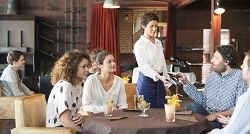Sandrine Andre, who is responsible for the digital economy in Strasbourg, is on a mission to change the perception of the traditional French city using an unlikely tool – NFC technology.
“Strasbourg is famous for its cathedral, its pretzels and its Christmas market but we want to show it’s an innovative territory,” says Andre.
A tall order perhaps, with the town dominated by black and white timber framed buildings along medieval streets. Towering over it all is the stunning sandstone Gothic Cathedral of Our Lady.
But Strasbourg has thrown its weight into NFC and is one of the towns that benefited from the French government’s Investissements d’avenir programme by receiving funding to test new tech.
Mobile Europe was given an exclusive tour around the city, where you can get tourist information, embark on tours, take the tram around the Grand Ile, pay for parking across 750 meters, and buy souvenirs using your mobile device to make contactless payments.
Anne Coreau, Local Project Manager for Orange Cash, says: “The mayor’s office has led the promotion of it. [French bank] Credit Mutuel’s headquarters are in Strasbourg so they used the city as a testbed for its payment system. They also equipped a lot of the shops with payment terminals.
“We are in the town in France that has the most NFC payment terminals, which leads to a virtuous circle between payment and equipment.”
The CTS public agency that runs the city’s transport network used the technology as an excuse to overhaul its outdated systems. The ticketing system uses the Calypso contactless payments standard, meaning that any changes can be made at the back office level and then applied to all of the terminals around Strasbourg.
Commuters download an app and can purchase a range of tickets from it. They then highlight whatever ticket they wish to use, before validating it at a contactless terminal.
Alain Caffert, CIO of CTS, says smartphones offer a greater sophistication to its contactless card payment system, which is used by the majority of commuters. “In a smart card, it’s hard to put a range of different fares into it. The validator does not know which ticket to use. With a smartphone you can differentiate which ticket you want.”
He says the main advantages for CTS is it gets greater information about customer behaviour and can use the app to push promotions and special offers. It is looking at smartphones to fill the gap left by the phasing out of magnetic cards. Around seven million are sold per year but their high cost is something CTS is keen to remove.
Hard sell
Dotted around Strasbourg are 1,800 signs and tags, allowing visitors to gain access to a tourist site through QR codes and NFC tags. On average 26,000 contacts are made per month, with visitors getting transport information or guides to many of the historic buildings.
However, Andre admits only 10 percent of connections are made using NFC. “It’s a little bit disappointing because some people with NFC phone would use QR codes,” she says. “They still don’t know how to use it.”
Adoption does appear to be an issue. Caffert says the NFC payments app has had 1,500 downloads, compared to the 200,000 holders of the smartcard. Despite the advantages, he says: “When people understand it, they keep using the system. It’s very difficult to explain the advantages… but we are sure it’s a much better system than the smartcard.”
At a branch of the Occitane retail chain, its manager says the technology is “at the beginning” when asked about how commonly NFC is used. “When the customer is younger, it’s better to explain,” she says. “After 60, it’s more difficult.”
Orange’s Coreau is unconcerned about the relatively slow rate of adoption, with the operator planning to bring NFC services to Lille, Rennes and Nice this year, as well as explore the potential of beacons.
She says: “On a smartphone, you have so many possibilities. How much of it do you actually use? Most of the people just look at what they have every day. They are not curious to see if [NFC] will work for them or not. You really have to do a lot of education.”
Apple’s recent announcement that its iPhones will finally have NFC, after years of speculation, will boost customer usage, according to Coreau.
“We have a very big job as a carrier for people to know what NFC is useful for. That’s why I think it’s so good Apple announced NFC in its iPhones. Even if we won’t get it in Europe for a while, the fact that they said they were interested will have others looking at it.”
Coreau adds that the doubling of NFC handsets from 20 six months ago to 34 now is also a boon but says NFC’s long-term adoption will depend on the volume of services offered. This is why Strasbourg has gone beyond the traditional use of NFC and solely offering contactless payments
“The more services they have available, the more they will use it,” she says. “In a town like Strasbourg, there are many services that can be used with it – tourism, parking, transport, shopping. If you have no services it will disappear but that is far from the case here.”


